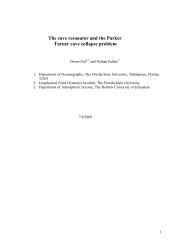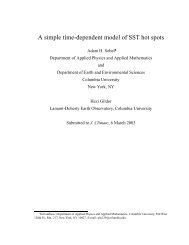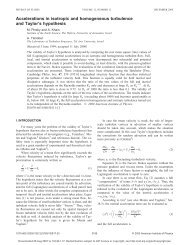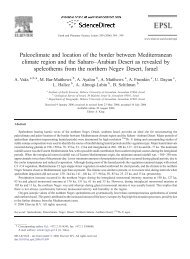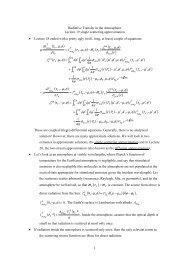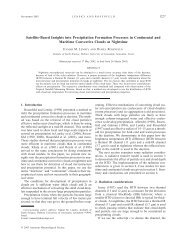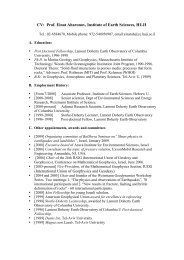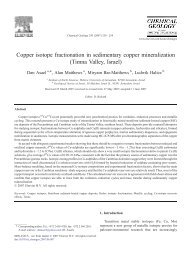Effects of photorespiration, the cytochrome pathway, and the ...
Effects of photorespiration, the cytochrome pathway, and the ...
Effects of photorespiration, the cytochrome pathway, and the ...
- No tags were found...
Create successful ePaper yourself
Turn your PDF publications into a flip-book with our unique Google optimized e-Paper software.
30 - 10 ANGERT ET AL.: BIOLOGICAL EFFECTS ON THREE O 2 ISOTOPESthis value in <strong>the</strong> numerical model, we found that thisdeviation from steady state will cause an increase <strong>of</strong> 4per meg in <strong>the</strong> value <strong>of</strong> 17 D, when it reached a plateau.Thus, 17 D W is 211 per meg instead <strong>of</strong> <strong>the</strong> 215 per megcalculated based on <strong>the</strong> steady state assumption. Thiscorrection for 17 D W is small with respect to o<strong>the</strong>r uncertainties<strong>and</strong> does not significantly change <strong>the</strong> value calculatedfor q 2 (0.511).[54] Ano<strong>the</strong>r nonsteady state effect results from <strong>the</strong> diurnalillumination cycle in <strong>the</strong> terrarium. Photosyn<strong>the</strong>sis tookplace in <strong>the</strong> few hours <strong>of</strong> illumination, while <strong>the</strong> uptakethrough dark respiration continued all day, <strong>and</strong> as a result<strong>the</strong> O 2 concentration fluctuated. By modeling this conditionin <strong>the</strong> numerical model, we found that it will cause <strong>the</strong> 17 Dvalue to fluctuate around <strong>the</strong> value 17 D BSS . The amplitude<strong>of</strong> <strong>the</strong> fluctuations in 17 D depends on <strong>the</strong> amplitude <strong>of</strong> <strong>the</strong>fluctuations in O 2 concentration. For interval ‘‘High,’’ wecan calculate from <strong>the</strong> dark periods that dark respirationconsumed about 9% <strong>of</strong> <strong>the</strong> O 2 reservoir <strong>of</strong> <strong>the</strong> terrarium perday. Using this value <strong>and</strong> <strong>the</strong> value <strong>of</strong> 0.9 for uptake toproduction ratio, <strong>the</strong> calculated magnitude <strong>of</strong> <strong>the</strong> 17 Dfluctuations resulting from <strong>the</strong> light-dark cycle is ±2 permeg. Again, this value is considerably smaller than <strong>the</strong>analytical uncertainty, <strong>and</strong> <strong>the</strong>refore this effect can be alsoneglected.5.5. Dependence <strong>of</strong> 18 E on Illumination <strong>and</strong> [CO 2 ]:Implication for <strong>the</strong> Dole Effect[55] The weighted-average 18 e <strong>of</strong> all <strong>the</strong> processes in <strong>the</strong>terrarium can be estimated from <strong>the</strong> terrarium equivalent <strong>of</strong><strong>the</strong> global Dole Effect (equation (14)), which is <strong>the</strong> value <strong>of</strong>Ln 18 O <strong>of</strong> ‘‘BSS’’ versus ‘‘W.’’ The Ln 18 O values <strong>of</strong> <strong>the</strong>terrarium air versus <strong>the</strong> value <strong>of</strong> <strong>the</strong> substrate water arepresented in Figure 4b. In <strong>the</strong> three intervals in which <strong>the</strong>17 D <strong>of</strong> <strong>the</strong> terrarium was constant, <strong>the</strong> Ln 18 O was almostconstant.[56] In interval ‘‘High,’’ <strong>the</strong> fractionation (e) in <strong>the</strong>terrarium according to equation (14) is 18.4 ± 1.8%, ininterval ‘‘Low’’ 23.9 ± 0.5%, <strong>and</strong> in interval ‘‘Variable’’21.7 ± 0.2%. The fractionation in interval ‘‘High’’ is inagreement with <strong>the</strong> known fractionation for <strong>the</strong> COX,18% [Guy et al., 1989], <strong>and</strong> with <strong>the</strong> fractionation thatwas calculated for <strong>the</strong> dark periods 16.7%. This agreementindicates that, as was assumed in section 5.3., <strong>the</strong>uptake in <strong>the</strong> terrarium was dominated by COX in interval‘‘High’’ in which <strong>the</strong> CO 2 concentration was high.[57] The fractionation by COX is 18%, in <strong>photorespiration</strong>it is 21.7%, <strong>and</strong> that <strong>of</strong> AOX is about30% [Ribas-Carbo et al., 2000]. Thus, <strong>photorespiration</strong><strong>and</strong> COX alone cannot explain <strong>the</strong> high Ln 18 O valuesmeasured in interval ‘‘Low’’ <strong>and</strong> interval ‘‘Variable.’’These high values seem to indicate that a considerableportion <strong>of</strong> <strong>the</strong> uptake was through <strong>the</strong> AOX. Since ininterval ‘‘Variable’’ <strong>the</strong>re was net production that introducedoxygen with light isotopic composition, <strong>the</strong> fractionationmust have been even stronger than that calculatedabove for <strong>the</strong> same interval according to <strong>the</strong> steady stateassumption ( 21.7%). The fractionation in interval‘‘Low’’ was extremely strong. The relative rate <strong>of</strong> uptakethrough <strong>the</strong> AOX in this interval was estimated from <strong>the</strong>observed Ln 18 O values in section 5.6. as 41–31% <strong>of</strong>gross production.[58] Some enrichment <strong>of</strong> <strong>the</strong> terrarium leaf water byevapotranspiration might have contributed to <strong>the</strong> highLn 18 O. However, since <strong>the</strong> relative humidity in <strong>the</strong> terrariumwas 100% this effect was probably very small. In fact,no enrichment was found when we compared <strong>the</strong> d 18 O<strong>of</strong><strong>the</strong> terrarium free water <strong>and</strong> <strong>the</strong> terrarium leaf water (datanot shown). However, this result might originate frommeasuring total leaf water, which includes depleted veinwater. Even if we assume that <strong>the</strong> enrichment at <strong>the</strong> site <strong>of</strong>photosyn<strong>the</strong>sis was as high as 1%, our main conclusionswill remain <strong>the</strong> same. The relative rate <strong>of</strong> <strong>the</strong> AOX ininterval ‘‘Low’’ will be 19–29%, still a very high figure,<strong>and</strong> <strong>the</strong> correction to q P (see section 5.6) will be muchsmaller than <strong>the</strong> o<strong>the</strong>r uncertainties.[59] The strong measured fractionation indicates that <strong>the</strong>AOX was activated in <strong>the</strong> same conditions that favorhigh rate <strong>of</strong> <strong>photorespiration</strong>-illumination <strong>and</strong> low CO 2 .This finding is in agreement with <strong>the</strong> indication for highAOX rates in <strong>the</strong> light inferred from in situ measurementsin a lake [Luz et al., 2002]. The CO 2 concentrationin <strong>the</strong> terrarium were very low (150 ppm), much lowerthan in most natural environments. However, since <strong>the</strong>relative humidity in terrarium was 100% stomatal conductancemust have been high. Consequently, <strong>the</strong> internalCO 2 concentration in <strong>the</strong> leaves was similar to that <strong>of</strong>midday in many natural environments. Since strongfractionation occurred not only with <strong>the</strong> 24 h d 1 illuminationbut also with <strong>the</strong> 10 h d 1 illumination, which iscloser to <strong>the</strong> natural cycle, we conclude that <strong>the</strong> engagement<strong>of</strong> <strong>the</strong> AOX in <strong>the</strong> light is likely also in manynatural systems.[60] In previous models <strong>of</strong> <strong>the</strong> Dole Effect, <strong>the</strong> global rate<strong>of</strong> <strong>the</strong> AOX was assumed to be very low <strong>and</strong> was neglected[Bender et al., 1994; Malaize et al., 1999]. This low rate isbased on measurements <strong>of</strong> <strong>the</strong> AOX activity in <strong>the</strong> dark.However, if <strong>the</strong> AOX activation is enhanced in illuminatedleaves in natural systems, <strong>the</strong>n its global rate should beconsiderably higher. This higher rate may help to close <strong>the</strong>gap between <strong>the</strong> calculated value <strong>of</strong> <strong>the</strong> Dole Effect (20.8%[Bender et al., 1994]) <strong>and</strong> <strong>the</strong> measured one (23.5%[Kroopnick <strong>and</strong> Craig, 1972]), <strong>and</strong> compensate for <strong>the</strong>weak fractionation recently reported for soil respiration[Angert et al., 2001]. The connection between <strong>photorespiration</strong><strong>and</strong> AOX might also explain past changes in <strong>the</strong> DoleEffect. Increased rate <strong>of</strong> <strong>photorespiration</strong> will be coupledwith an increased rate <strong>of</strong> AOX. Drier <strong>and</strong> hotter climate isexpected to cause an increased rate <strong>of</strong> <strong>photorespiration</strong>, aswell as more evapotranspiration that will result in 18 Oenriched leaf water. Thus, such climate will cause anincreased Dole Effect by both heavier composition <strong>of</strong> leafwater <strong>and</strong> increased rate <strong>of</strong> <strong>photorespiration</strong> <strong>and</strong> <strong>the</strong> AOX,two processes that have high fractionation relative to that <strong>of</strong>COX.5.6. Estimating <strong>the</strong> Q <strong>of</strong> Photorespiration[61] The average q in <strong>the</strong> terrarium in interval ‘‘Low’’ was0.511. This value <strong>and</strong> <strong>the</strong> values found for <strong>the</strong> AOX <strong>and</strong>COX, can be used to estimate <strong>the</strong> q associated with photo-



